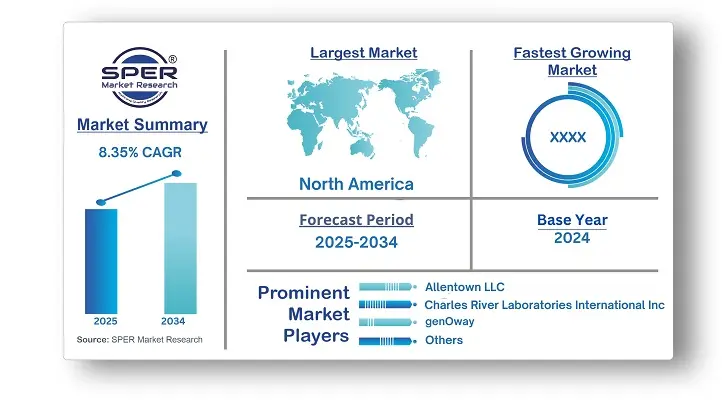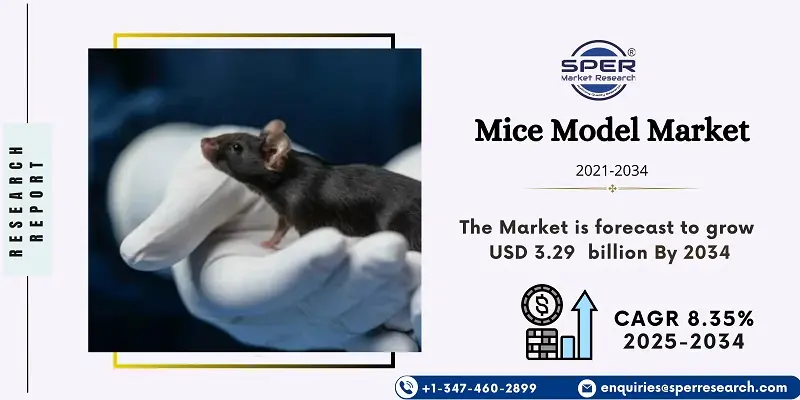Mice Model Market Introduction and Overview
Global Mice Model Market is projected to be worth 3.29 billion by 2034 and is anticipated to surge at a CAGR of 8.35%.
The report includes an in-depth analysis of the Global Mice Model Market is, including market size and trends, product mix, Applications, and supplier analysis. The global mice model market is steadily growing due to their increasing use in biomedical research, drug development, and disease modelling. Advances in genetic engineering have enhanced the precision of these models for studying complex diseases like cancer and neurological disorders. Furthermore, the emphasis on personalized medicine and biologics is increasing the demand for mouse models in preclinical testing. The rise of contract research organizations is also improving access to specialized models, encouraging broader use in academic and commercial research.
By Mice Type Insights
The global mice model market includes inbred, outbred, genetically modified, hybrid, and conditioned mice, each serving specific research needs. Inbred models offer reproducibility, outbred models reflect population diversity, and genetically modified mice aid in disease studies. Hybrid and conditioned mice support gene interaction and specialized medical research. Each type is vital for advancing biomedical science and addressing diverse research needs.
By Technological insights
The global mice model market utilizes various technologies for genetic engineering. The CRISPR/Cas9 system facilitates accurate gene modification for disease models, whereas microinjection is utilized to create transgenic mice. Embryonic stem cell injection creates chimeric mice for gene function studies, and nuclear transfer is used for cloning. Each technology serves specific research goals, contributing to advancements in drug development, disease modeling, and personalized medicine, depending on the objectives of the study.
By Application Insights
The global market for mouse models serves various biomedical research applications. In oncology, genetically modified mice aid cancer therapy development, while in neurology, they help study neurodegenerative diseases. Immunology research uses immunodeficient mice to explore human immune responses and test therapies. Moreover, mice play a vital role in pharmacology and toxicology for preclinical drug assessments and are utilized in studies related to metabolic, cardiovascular, and infectious diseases, thereby contributing to the advancement of personalized medicine and drug development.
By End User Insights
Pharmaceutical and biotechnology firms mainly utilize mice models for preclinical drug development, efficacy testing, and safety assessments. Academic and research institutions are becoming more important due to increased R&D investments and industry collaborations. Contract research organizations (CROs) are vital for outsourcing preclinical studies, offering specialized expertise and resources. Furthermore, contract development and manufacturing organizations (CDMOs) help produce genetically modified mice for commercial use.
Regional Insights
North America leads the global mice model market, driven by strong pharmaceutical research and development as well as infrastructure. The Asia-Pacific region is undergoing swift development, bolstered by investments in biotechnology in both China and India. Meanwhile, Latin America and the Middle East & Africa are emerging markets that are demonstrating consistent growth due to improved research efforts and international collaborations.
Market Competitive Landscape
Major players in the worldwide mice model market consist of Charles River Laboratories, The Jackson Laboratory, Taconic Biosciences, genOway S.A., Janvier Labs, and Harbour BioMed, among others. These companies are focused on introducing new products and entering new markets to meet the increasing global consumer demand and improve their specialized product lines. Their significant global footprint allows them to serve a wide range of customers, thus enhancing their market share.
Recent Developments
In February 2024, the University of Texas Southwestern Medical Center introduced a new compound that significantly extended survival in a mouse model of ALS by inhibiting MAP4K proteins.
In November 2023, UCI MODEL-AD researchers created the Trem2R47H NSS mouse model to enhance understanding of Alzheimer's disease, incorporating the TREM2 R47H genetic variant, a key risk factor for late-stage Alzheimer's in humans.
Scope of the report:
| Report Metric | Details |
| Market size available for years | 2021-2034 |
| Base year considered | 2024 |
| Forecast period | 2025-2034 |
| Segments covered | By Mice Type, By Technology, By Application, By End User |
| Regions covered | North America, Latin America, Asia-Pacific, Europe, and Middle East & Africa |
| Companies Covered | Allentown LLC, Charles River Laboratories International Inc, genOway, Harbour Biomed, Hera Biolabs, Inotiv, Janvier Labs, PolyGene, Taconic Biosciences, Inc, The Jackson Laboratory.
|
Key Topics Covered in the Report
- Global Mice Model Market Size (FY’2021-FY’2034)
- Overview of Global Mice Model Market
- Segmentation of Global Mice Model Market By Mice Type (Inbred, Outbred, Knockout, Hybrid, Other Mice)
- Segmentation of Global Mice Model Market By Technology (CRISPR, Microinjection, Embryonic Stem Cell Injection, Nuclear Transfer, Other Technologies)
- Segmentation of Global Mice Model Market By Application (Research & Development, Production and Quality Control, Academics, Other Applications)
- Segmentation of Global Mice Model Market By End User (Companies, Organisations, Academic and Research Institutes, Contract Research Organizations)
- Statistical Snap of Global Mice Model Market
- Expansion Analysis of Global Mice Model Market
- Problems and Obstacles in of Global Mice Model Market
- Competitive Landscape in the of Global Mice Model Market
- Details on Current Investment in of Global Mice Model Market
- Competitive Analysis of Global Mice Model Market
- Prominent Players in the Global Mice Model Market
- SWOT Analysis of Global Mice Model Market
- Mice Model Commercial Gas Boiler Market Future Outlook and Projections (FY’2025-FY’2034)
- Recommendations from Analyst
1. Introduction
1.1. Scope of the report
1.2. Market segment analysis
2. Research Methodology
2.1. Research data source
2.1.1. Secondary Data
2.1.2. Primary Data
2.1.3. SPER’s internal database
2.1.4. Premium insight from KOL’s
2.2. Market size estimation
2.2.1. Top-down and Bottom-up approach
2.3. Data triangulation
3. Executive Summary
4. Market Dynamics
4.1. Driver, Restraint, Opportunity and Challenges analysis
4.1.1. Drivers
4.1.2. Restraints
4.1.3. Opportunities
4.1.4. Challenges
5. Market variable and outlook
5.1. SWOT Analysis
5.1.1. Strengths
5.1.2. Weaknesses
5.1.3. Opportunities
5.1.4. Threats
5.2. PESTEL Analysis
5.2.1. Political Landscape
5.2.2. Economic Landscape
5.2.3. Social Landscape
5.2.4. Technological Landscape
5.2.5. Environmental Landscape
5.2.6. Legal Landscape
5.3. PORTER’s Five Forces
5.3.1. Bargaining power of suppliers
5.3.2. Bargaining power of buyers
5.3.3. Threat of Substitute
5.3.4. Threat of new entrant
5.3.5. Competitive rivalry
5.4. Heat Map Analysis
6. Competitive Landscape
6.1. Global Mice Model Market Manufacturing Base Distribution, Sales Area, Product Type
6.2. Mergers & Acquisitions, Partnerships, Product Launch, and Collaboration in Global Mice Model Market
7. Global Mice Model Market, By Mice Type (USD Million) 2021-2034
7.1. Inbred
7.2. Outbred
7.3. Knockout
7.4. Hybrid
7.5. Other Mice
8. Global Mice Model Market, By Technology (USD Million) 2021-2034
8.1. CRISPR
8.2. Microinjection
8.3. Embryonic Stem Cell Injection
8.4. Nuclear Transfer
8.5. Other Technologies
9. Global Mice Model Market, By Application (USD Million) 2021-2034
9.1. Research & Development
9.1.1. Infectious Disease
9.1.2. Immunological Diseases
9.1.3. Cancer
9.1.4. Cardiovascular Diseases
9.1.5. Diabetes
9.1.6. Genetic Diseases
9.1.7. Neurological Diseases
9.1.8. Other Diseases
9.2. Production and Quality Control
9.3. Academics
9.4. Other Applications
10. Global Mice Model Market, By End User (USD Million) 2021-2034
10.1. Companies
10.1.1. Pharmaceutical
10.1.2. Biotechnology
10.1.3. Cosmetics
10.1.4. Other Companies
10.2. Organisations
10.2.1. Government
10.2.2. Non-government
10.3. Academic and Research Institutes
10.4. Contract Research Organizations (CRO)
11. Global Mice Model Market, By (USD Million) 2021-2034
11.1 Global Mice Model Market Size and Market Share
12. Global Mice Model Market, By Region, (USD Million) 2021-2034
12.1. Asia-Pacific
12.1.1. Australia
12.1.2. China
12.1.3. India
12.1.4. Japan
12.1.5. South Korea
12.1.6. Rest of Asia-Pacific
12.2. Europe
12.2.1. France
12.2.2. Germany
12.2.3. Italy
12.2.4. Spain
12.2.5. United Kingdom
12.2.6. Rest of Europe
12.3. Middle East and Africa
12.3.1. Kingdom of Saudi Arabia
12.3.2. United Arab Emirates
12.3.3. Qatar
12.3.4. South Africa
12.3.5. Egypt
12.3.6. Morocco
12.3.7. Nigeria
12.3.8. Rest of Middle-East and Africa
12.4. North America
12.4.1. Canada
12.4.2. Mexico
12.4.3. United States
12.5. Latin America
12.5.1. Argentina
12.5.2. Brazil
12.5.3. Rest of Latin America
13. Company Profile
13.1. Allentown LLC
13.1.1. Company details
13.1.2. Financial outlook
13.1.3. Product summary
13.1.4. Recent developments
13.2. Charles River Laboratories International Inc
13.2.1. Company details
13.2.2. Financial outlook
13.2.3. Product summary
13.2.4. Recent developments
13.3. genOway
13.3.1. Company details
13.3.2. Financial outlook
13.3.3. Product summary
13.3.4. Recent developments
13.4. Harbour Biomed
13.4.1. Company details
13.4.2. Financial outlook
13.4.3. Product summary
13.4.4. Recent developments
13.5. Hera Biolabs
13.5.1. Company details
13.5.2. Financial outlook
13.5.3. Product summary
13.5.4. Recent developments
13.6. Inotiv
13.6.1. Company details
13.6.2. Financial outlook
13.6.3. Product summary
13.6.4. Recent developments
13.7. Janvier Labs
13.7.1. Company details
13.7.2. Financial outlook
13.7.3. Product summary
13.7.4. Recent developments
13.8. PolyGene
13.8.1. Company details
13.8.2. Financial outlook
13.8.3. Product summary
13.8.4. Recent developments
13.9. Taconic Biosciences, Inc
13.9.1. Company details
13.9.2. Financial outlook
13.9.3. Product summary
13.9.4. Recent developments
13.10. The Jackson Laboratory
13.10.1. Company details
13.10.2. Financial outlook
13.10.3. Product summary
13.10.4. Recent developments
13.11. Others
14. Conclusion
15. List of Abbreviations
16. Reference Links


































